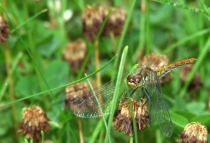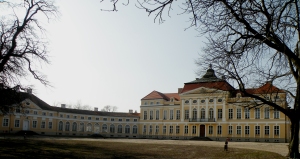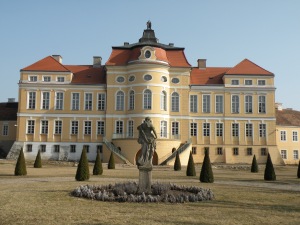I haven’t been writing for a while now and really feel bad about it. I still need to finish my Vietnam story especially that now comes the time to describe Mekong Delta trip. It’s just that I don’t really know how to write about it, but bear with me. It’s coming.
In a meanwhile let me share some pictures from a lovely place near where I live in Poland. We went there with my best friend recently in an attempt to sightsee some of Wielkopolska nicest palaces and castles. More should follow.
Some facts:
- Rogalin is primarily famous for its 18th-century baroque palace of the Raczyński family which has been in recent years renovated
- It was erected on a rectangular plan. The centre part of the front elevation, which dominates the entirety, is crowned with a triangular pediment bearing the Raczyński (Nałęcz) coat of arms and the garden elevation has a semi-circular protruding terrace
The building has two storeys from the front and three from the garden side owing to the slope of the terrain. The entrance to the sala terrena on the ground floor is shaped like a sea grotto. The entire body is dominated by a cupolaed garret, the central part of which is crowned with a sculpture bearing the initials “KR” (from the founder Kazimierz Raczyński)
- It houses an art gallery with Polish and international paintings (including Paul Delaroche and Claude Monet and the famous Jan Matejko’s large-scale painting Joanna d’Arc)
- There is a lovely French garden at the back of the palace which then extends into an English style landscape park with famous 1000-year-old oak trees called Lech, Czech and Rus (‘ll tell you two legends about those three heroes so notice the names)
- It’s has a cafe in old carriage house and stables you can visit, but what I would recommend is to make a picnic on Warta riverbanks as we used to do when I was a child
The picture on the left shows the view of the palace from the French back garden. It’s not very green yet so it might loose some of it charm, but you can still appreciate the building.
but you can still appreciate the building.
The statues, located here and there in the garden, are of mythological creatures and gods. I remember as children we used to run inside the green labyrinths and pretend we take part in stories full of mystery and danger.
We’d always visit the oak trees and then head towards the river banks for a walk and picnics. I can’t remember swimming in the river besides this one time in high school when we visited summer cottage of one of my friends near Rogalin. We actually swam in a small pond for bathing cows next to the river, not in the river itself. In the summer you can see some boats with anglers forever waiting to catch a fish. Meadows surrounding the banks are full of wild life and here is a picture of dragonfly I took on one of my trips there. 
Now, first of promised two legends about three brothers.
Three brothers Lech, Czech and Rus went hunting together but each of them followed a different prey and eventually they all travelled in different directions. Rus went to the east, Czech headed to the south to settle in the Bohemian hilly countryside, while Lech travelled north. There, while hunting, he followed his arrow and suddenly found himself face-to-face with a fierce, white eagle guarding its nest from intruders. Seeing the eagle against the red of the setting sun, Lech took this sight as a good omen and decided to settle there. He named his settlement Gniezno (similar to Polish gniazdo – ‘nest’) in commemoration and adopted the White Eagle as his coat-of-arms. The white eagle remains a symbol of Poland to this day, and the colour of the eagle and the colour of the setting sun are depicted in Poland’s flag.
Another legend with the three brothers refers to how the city of Poznan (where I was born and live nowadays) was founded. Several long years have passed from the time since the three brothers, Lech, Czech and Rus, said goodbye to each other. When a cheerful, golden autumn came Lech gathered his team and set out on a great hunt. They headed west and soon entered the vast forest. Time and time again the team came across cluster of timid or buck deer. Sometimes, the earth rumbled from heavy jog of herd of bison or aurochs. Then the forest was filled with dog clatter, clatter of horses’ hoofs and horns playing fighter announcements of triumph. On the third day morning, in pursuit of a powerful tur, they came to the Cybina river, where a fishermen village laid. Suddenly from the midnight forest rang the sound of distant horns came.
“Who can it be!?” exclaimed Lech. Warriors looked around – everybody was there. The first horn was heard then the second and third.
“The enemy is probably some invaded our lands” said Lech “we have to go back to the edge of the forest and prepare to repel the attack!” Archers and Javelineers hid behind trees, and the warriors prepared bows and swords and formed the order of battle. Meanwhile, playing horns were closer and closer. Wind has already reported the tramp of horses’ hooves and the buzz of people. Finally leaning out of the wilderness a large team of warriors appeared. At its head drove the two leaders. They were going straight towards the village.
Lech ordered his warriors horn the battle-cry and then rolled his hands in a tube and exclaimed: “Who are you and what are you looking for in a foreign land?”
“It’s no Man’s Land and what we seek is ours!” reply came. There was nothing to wait on. Lech shouted the order to archers, and he along with his team hit the enemy like a whirlwind. Already were they to cross the swords, when Lech suddenly threw weapon on the ground and cried joyfully “Czech! Russ! I recognize you (poznaje in Polish)! Welcome!”
Amazed warriors of both teams Put your sword and then began to welcome each other. The three brothers, Lech, Czech and Rus, fell into each other arms and embraced long and heartily. Lech decided to celebrate worthily the meeting with the brethren, ordered to light fire and roast the deer. As they ate and honey loosened tongues, Czech and Rus in turn began talking about several years of their wanderings among the Slavs beyond the Oder.
When the cup of honey made a circle around the campfire Lech said: “This day will remain forever in our memory as the day we met after many years of separation. In memory of this meeting I will build on the site new settlement
fort and name it Poznan.
And so it happened. In the spring of next year Lech built on the right bank of the Warta fortified city Poznan. In the borough artisans and merchants started to build their houses. This created a city of Poznan, which with time expanded to the left bank of the Warta.



